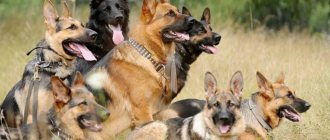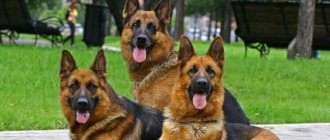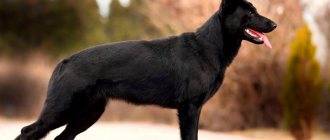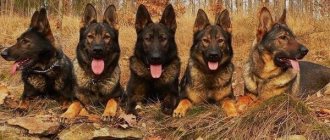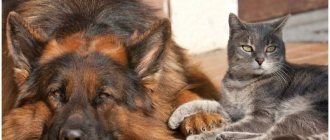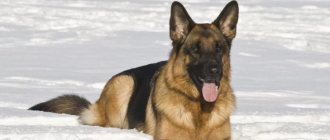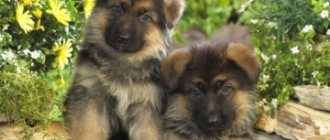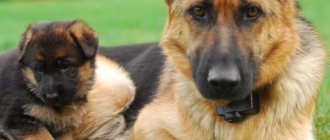Most representatives of the German Shepherd breed are black-and-white. More than 90% of individuals of this breed are distinguished by black body hair with large tan markings on the chest, paws and belly of the pet. This is partly why in the minds of people far from cynology, there was an erroneous opinion that a shepherd dog cannot be of a different color.
How do German Shepherds change color?
The color of the German Shepherd changes gradually. Most newborn puppies have dark coats that look about the same. During the molting period, it turns from smooth and soft to hard. If the puppy has a zonal type color, and the appearance of the additional color is pale brown, with age it acquires brightness and becomes red-red. A gray dog in childhood has the shade of a dirty rag. At four months the fur gradually falls out, by seven months the saddle cloth is already clearly outlined, and by one year the coat ends and the color no longer changes. During the molting period, puppies need to be looked after - combed using a comb or furminator.
Coat types
The coat of this breed has an undercoat. The hair is tightly adjacent to each other, straight and hard. There is usually short hair on the inside of the ears, head, front of the limbs and paws, and slightly longer hair on the neck in the form of a collar.
By hair type, in addition to short-haired individuals, there are also long-haired ones. Moreover, the latter have wool that is both soft and hard. Oddly enough, dogs with such hair are less able to tolerate low temperatures, so in the cold season there are problems with keeping them outside the home.
Long-haired dog breeds should not be allowed to live outdoors as they may develop health problems.
Color of working shepherd dogs
To have a clearer idea of such a dog, take a look at the photo below of a zone-colored German Shepherd puppy. What does this color look like according to the RKF description?
The lower part of the coat is light. Slightly higher wool is sable-colored. The “saddle cloth” is followed by a yellow-brown tint. It alternates with gray color. And the finishing touch is black.
Unusual shades
There are rare colors that are unique to some breeds. Blenheim is a rich chestnut color stain. They are arranged on a base of pearly white color. The color is found only in the Cavalier King Charles Spaniel. There should be a white diamond on the parietal part, and a chestnut-colored spot in the central part.
Merle is an uneven coat color. Appears in dark or light tones of the same color. This color is found in pit bulls.
Origin story
Black-backed coloring did not originally exist among German Shepherds. Although, perhaps, already in the old days there were individuals of a zone-red color, which could conditionally be classified as animals with a weakened saddle.
But the ancestor of the breed, the famous Horand von Grafrath, was of a zone-gray color, and he consistently passed on this coat color to most of his descendants.
Read also: Treatment of alcoholic dementia
That is why in the first half of the 20th century, the zonal color predominated among German shepherds, however, later, along with gray, dogs with a reddish coat also appeared, which became the ancestors of the saddle-backed shepherd dogs.
The first “Germans” with such coat colors created a real sensation in the world of dog breeding.
Unlike the more modestly colored zonal shepherd dogs, due to the contrasting combination of reddish, brownish and black fur, they looked bright, elegant and unusual for their time.
IMPORTANT!
The new color quickly began to gain popularity, so that most breeders of show dogs began to breed mainly saddle-colored German shepherds.
Zone dogs, in general, turned from show beauties into working dogs, since in the exterior rings many of them lost to the more impressive-looking saddle-backed shepherd dogs.
By now, the saddle color of the “Germans” has long been considered a classic color. And thanks to the fact that such dogs are constantly featured in films, most lovers cannot even imagine that a shepherd dog could have a different coat color.
Types of “Germans” by color
According to the standard, there are four main options:
- black;
- black and tan;
- zonal;
- black colored dogs.
German Shepherds are great dogs
The former are considered a kind of elite of the world of shepherd dogs; they are very rare (only 5% of the representatives of the breed). A small amount of brown hair is allowed between the toes and on the hocks. The standard also allows a gray undercoat on the pet’s neck and shoulders.
For your information! An interesting trend was noted by M. Ray, an American breeder specializing in precisely these types of breeds. If you purposefully study this color, then in each subsequent generation the proportion of brown-gray inclusions decreases, and the puppies of the fourth generation are already charcoal.
Black and tan dogs are beautiful, the tonality of their coat is predominantly black, which is why they can appear charcoal, a copy of the previously described variety.
The Zonar is the oldest variant of the German Shepherd, called the Agouti. Each hair is colored in several shades: white at the base of the hair, then yellow-brown along the main length, and black at the tip. This coloring helped wild dogs to camouflage themselves in nature while tracking down prey. The dominant gene contributes to this coloration.
Black and red is a black and red color variant that is considered the most popular. It is these animals that become prize-winners at monobreed exhibitions.
German Shepherds are amazingly beautiful
Care
Whatever color your pet is, it will require care. If you decide to get a German Shepherd, be prepared to feed him quality foods that are high in protein. The basis of the diet should be meat. You can feed her with industrial food, but in this case you need to choose only premium food.
Fatty and floury, sweet and smoked foods should not be given, this is very harmful and can lead not only to obesity, but also to diseases of various internal organs. Portions should be adjusted based on weight and lifestyle; dogs that move a lot need more nutrients.
It is important to monitor the animals’ eyes, because these are weak points for them. If there is purulent discharge or inflammation, contact your veterinarian. Wipe them regularly with chlorhexidine or a strong infusion of tea.
Vaccinate your pet as necessary, give it anthelmintic drugs, and comb its hair. A shepherd dog may be allergic to a certain product or the type of dry food; this disease is similar to a skin disease, and in order to diagnose it, it is important to contact a veterinarian in time.
Do not forget about constant movement, which plays a big role in the proper development of the puppy and the preservation of youth as an adult representative of the breed. Active games promote healthy joints, spine and good mood.
About once a week, conduct a home inspection of your pet, clean its ears and eyes. If there are any deviations from the norm, contact the clinic. Of course, such dogs live best in a private home, and on the street. But they are able to live in an apartment, only then you need to walk with them for a very long time. They need physical activity, movement and communication with their owner. It is better if it takes place in the fresh air. In any case, you will have to talk to your pet very often, pet him, show him that he is important, and then he will be healthy and live a long, happy life.
Education and training
The animal lends itself well to training, and it is better to start training from an early age (a good option is immediately after weaning from the mother). Basic instructions regarding training:
- Young dogs are able to learn simple commands in a few repetitions, and training is recommended in a playful way. For successful execution of the command, you need to give the dog his favorite food (for example, food or a small piece of meat).
- Before training, you need to give the animal a nickname, and in order to reinforce the response, you need to constantly call the animal by its nickname. When the animal learns its name, it is necessary to learn the basic simple commands - “Come to me”, “Give me a paw”, “Sit”, “Fu”, “No” and others.
- The animal must have a special place in its house where it will rest. The area may contain a pillow, blanket, and a few of your pet's favorite toys. Such a place cannot be moved frequently - otherwise the animal will quickly lose interest in it.
Zone color
Puppies of the zone color, which is also called wolf color, are becoming less and less common today - some of the young dog breeders have never even seen a representative of the classic “wolf” color. However, it is generally accepted that it is the zonal coloring that is the original for representatives of the German breed - all other options are its derivatives.
The color zones in such dogs are distributed in rings - hairs with black tips, with a zone of black or brown shade, then again black and with a base of a light shade.
The zone-gray color is dominant in the German breed - if during mating one of the parents is gray in color, this will definitely show up. However, on the other hand, this gene does not exist in a recessive form, therefore it will not be possible to obtain it on the basis of zonal or black-and-white flowers. Consequently, if the producers of the zone-gray color disappear, it will be lost forever to posterity.
Advertising:
However, breeders who follow fashion trends and think more about financial interests than about the conservation of endangered species, rarely think about the consequences of underestimating the factors contributing to the disappearance of the “wolf” color. Therefore, it is worth talking about this more often and more in order to be able to avoid danger and correct the existing situation.
Black
This suit does not need a complex characterization. The main indicator is a glossy black color and the absence of any marks. The chest and paws marked with white spots will be considered faults in the conformation of the exhibited dog.
Dogs with light eyes are considered weakly pigmented, even if they are completely black. And also if there are white spots and tan coming through. Interestingly, the heredity of weak pigmentation in them is much stronger than in other species.
From birth, black puppies do not change their color later. The combination of two genes, being recessive, resulted in a genetically stable color in the dog. This explains the small percentage of black dogs compared to the other two.
To get black puppies , it is recommended to breed shepherd dogs of the following colors:
- black-black;
- black-saddle cloth;
- saddlecloth-saddlecloth (only in a situation where one of the dogs had a black sire in the family);
- black-zonar;
- zonar-zonar (zonar, at the gene level, in itself, is a carrier of dark pigment).
Let's consider one more suit, it's called
Dimensions, weight and other distinctive features
The black-backed German Shepherd is a dog of above average height, with a height of 55 to 65 cm at the withers.
Weight
The main distinguishing feature of these dogs is the presence of a dark saddle-shaped spot covering the neck, shoulders, as well as the back and sides of the shepherd from the withers to the tail . The saddle cloth, or, as it is also called, the mantle, can be of various shapes and sizes.
It can also be either saturated, coal-black, or weakened - grayish or even brownish.
NOTE!
The main color, called tan, with black-and-white color comes in varying intensities: from light, yellowish, to very bright and rich, reddish-brown.
Most black-backed German Shepherds have more or less pronounced darkening on the face, often looking like a black mask.
The edging of the eyelids and lips are exclusively black.
Good pigmentation is mandatory for a dog of this color, since its absence indicates a weakened genotype in animals of this line.
Standard colors
The standard refers to the color scheme with which dogs are admitted to international exhibitions.
Cheprachny
What is saddleback color: this is a common look, found in 90% of the breed. The animals have a black, V-shaped spot on their back, which extends to the sides and upper part of the tail. The lower part is painted in a lighter tone.
Three options are allowed:
- yellowish or fawn;
- chocolate or brownish;
- grey.
A black mask covering the face and ear area must be present.
Black-backed German Shepherd
Black and Tan
It is a variation of the saddle color and is not considered an independent tone. The main shade is black, with small reddish-brown patches in the area of the paws and belly. Faded spots located on the cheekbones, chest and eyebrows are found in some individuals.
Black
Found in 3-5% of animals, its unusual appearance is highly valued among professionals. The color of the shepherd dogs is solid, foreign inclusions are not allowed.
A feature of the color scheme for girls and boys is the fact that the tone can only change as they grow older (after 6-12 months) and regularly molt.
Charcoal shade
German Shepherd of zonal color
There are secondary names for the zone color, it is called gray, wolf, gray and agouti. This variation was present in the first purebred animals, making them similar to wolves. Occurs in 5% of representatives, the tone is unevenly distributed: closer to the skin it is paler, then darker, with a gradual transition to yellow, and at the ends of the hairs it is black.
The color becomes more intense in the area of the back, tail and muzzle. On other parts it noticeably loses brightness. According to the standards, any shade is allowed - from yellowish to rich brown.
Dark sable or black-zoned
The secondary name of the color is wolf, wild. Initially, the dog appears brownish-black, but upon closer inspection, a grayish or reddish tail, lower abdomen, paws, neck and ears are visible.
Eye and skin color
According to accepted standards, the iris of representatives cannot be black; dark tones are allowed.
The shades of fur and eyes are not comparable; dark animals have light variants and vice versa. Important! Cynologists believe that if the color of the irises and coat are combined, then such individuals look more attractive than their counterparts.
In the presence of a colorless, blurry color, pets have a darkish rim around the eyes and small blackish spots on the tongue. The skin of individuals has a gray-blue tone, with pink under the tan. The nose is painted in deep dark undertones.
Color variations
Skin pigmentation
The expressive expression of the muzzle is acquired due to the mask located around the organs of vision. One of the dominant genes is responsible for its appearance, which also causes its dark shade. With darkish tones of color, the mask is weakly expressed, and with dull tones, it is more saturated. If there is no nuance, then this is a sign of marriage and a direct path to the pet class.
Animals with a black and tan tone do not have it; the muzzle is a solid black shade. The throat area has brown fur, and the lips are liver-colored.
Black color sets the tone for the forehead and eyebrows, the final result depends on the depth of the main one:
- in deep dark conditions, the front part will be charcoal;
- with a lightened mantle - with light eyebrows.
When purchasing a baby, you must carefully check the documents and registration of the animal in one of the canine associations. For those who have decided to try their hand at breeding, the best solution would be to purchase a new family member from a professional nursery. If the issue of exhibitions does not arise, then you can find an animal of any shade - intelligence indicators and working qualities do not suffer from the changed coat color.
All about black-backed German Shepherds
The black-backed German Shepherd is extremely popular among professional breeders. This noble and beautiful dog is a regular participant in many exhibitions. Purebred representatives of the breed have their own temperament, working qualities, and also require certain conditions of maintenance, so before getting such a pet you need to carefully study the rules of caring for it.
Black-haired German Shepherds appeared in Germany in the mid-19th century, bred by Max Frederick von Stephanitz. The progenitor of the breed is the male Greif; this dog had a dirty white coat color, he was distinguished by his stately posture and unusual intelligence. The only thing that did not suit the breeder was the color of the pet’s coat, which did not meet the breed standards.
A few years later, the breeder finally managed to get the noble color of the dog, and already in 1924 the first beauties were brought to Russia. At first, many problems arose with their breeding, since there were not enough skills and funds for maintenance, but over time, a kennel club opened in the country, and its representatives began to actively breed healthy pets.
Black Sheepdogs have an elongated body shape, but do not look squat. Their body is proportional, all parts are harmoniously combined with each other. The length of the head is 40% of the height at the withers. The skull and muzzle are equal in length. The head is of medium width and wedge-shaped, while in females it is less massive than in males.
The dog's ears are small, erect, triangular in shape and slightly rounded at the tips. The eyes of a black-backed shepherd dog are oval, dark, their gaze is alert and intelligent. The nose is black and quite large. The neck is characterized by well-developed muscles and is set at an angle of 45 degrees. Dogs of this species have especially pronounced withers, they are sloping and slightly elongated.
When animals are in an interested state, their tail rises, and in a calm state it is lowered. The dog's limbs are straight and strong, the hind legs are slightly longer than the front legs, they are muscular. As for wool, it can be either hard, short, or soft, elongated. The dog is of average height, its height ranges from 55 to 65 cm. The weight of individuals reaches from 22 to 40 kg.
The main distinguishing feature of these German Shepherds is the presence of dark spots on the fur, which resemble the shape of a saddle cloth. The spots are located on the back, shoulders, neck, withers and tail. They can be of various sizes and shapes, and can also be intensely or lightly colored.
The pet of this breed is an attentive, very intelligent and devoted pet to its owner. His character is characterized by distrust of strangers, determination and courage. Such dogs make excellent bodyguards and guards, since it is almost impossible to bribe and deceive them. Since a shepherd dog of this species, with proper upbringing, becomes obedient, it never attacks strangers without the owner’s command, but if he is not around, he can make decisions on his own. The Black Sheepdog is considered universal; it is usually bred as:
- companion dogs;
- a reliable security guard;
- service dog;
- guide
The main advantages of this breed include: fast learning, loyalty, a fairly high level of intelligence, protective instincts and good working qualities. As for the disadvantages, there are few of them: dogs constantly need physical activity and require systematic training.
These charming fluffy balls will not leave anyone indifferent. Puppies of this breed have large paws, an innocent look and look like clumsy bear cubs. It is best to purchase babies in specialized nurseries (military or private), which are engaged in professional breeding of purebred individuals. If you plan to prepare your pet for a show career, then immediately after acquisition he needs to be provided with proper upbringing and proper care.
Purebred babies, in addition to having a pedigree, must also have a certificate of suitability for breeding; the breed line should not contain representatives who suffer from genetic diseases and other deviations from the breed.
Before choosing a suitable puppy, you need to pay attention to the previous conditions of its maintenance, as well as the relationship with the mother dog. Usually up to 11 puppies are born in one litter. Preference should be given to those individuals who are distinguished by their appearance, good manners and fatness.
Healthy baby black-haired shepherd dogs move confidently and stand on their paws, are perfectly oriented in the surrounding space, have an intelligent look, and clean and shiny fur. They are active and inquisitive, and do not show cowardice or signs of aggression. The body of the puppies is elongated, but not square. The ears of small shepherd dogs under the age of 2-3 months droop, but if the tips of the shells are in a standing position, then this is a sign of ossification of cartilage caused by improper phosphorus-calcium metabolism. The tail of puppies is straight and unkinked.
Up to two months of age, puppies' eyes may have a blue tint, but this disappears over time. It is recommended to separate babies from their mother at an early age; this is best done when they are 2.5-3 months old. The older the dog, the more difficult it is to train it and wean it from bad habits.
Shepherd dogs of this species are distinguished by their unusual coat color. The black and tan color is dominant in relation to the black color gene, but it prevails over the black and tan shade. Sometimes in nature there are individuals whose saddle cloth is weakened; this is due to the loss of the intensity of the black color on the back. If, when breeding dogs, the descendants of black-backed parents are used without admixture of other genes, then the color becomes lighter over time.
The main feature in the color of these shepherd dogs is that the saddle cloth (“black mantle”) can smoothly descend to the paws of the animal. As for the lower part of the body, it can be:
- red;
- gray;
- yellow;
- light brown.
The muzzle of dogs has a “dark mask”; the color of the chest can vary from black to light. Often there is a black “tie” on the chest. The scoop of each individual may have a different pattern and shade.
Black-haired German Shepherds are characterized by a long life; if kept in good conditions, pets live up to 14 years. Despite the fact that individuals of this breed are distinguished by good health, they can sometimes be susceptible to such ailments as allergies, diseases of the gastrointestinal tract, and inflammatory processes in the ears. Dogs also suffer from skin diseases (dermatitis, eczema) and hip dysplasia.
In addition, pets of this breed are predisposed to gastric volvulus, so for their feeding it is necessary to create a strict schedule, try not to overfeed the pet and ensure that it is at rest for 3 hours after eating.
Before you bring a black-backed German Shepherd into your home, you need to know that it will shed heavily. Therefore, you should be prepared for the fact that your pet will have to be combed at least 4 times a week. In addition, the dog needs to be mentally and physically trained and walked in the fresh air. For those owners who spend most of their time at work and on weekends they just like to lie on the couch, this breed of dog is not suitable.
German Shepherds are not particularly demanding in terms of care, but their owners need to regularly monitor the condition of their pets' teeth and ears. It is recommended to thoroughly brush your teeth with a specially designed toothpaste; periodically, dogs should be allowed to chew on fresh bones. The ears are wiped with a damp swab twice a month.
To prevent the animal's claws from causing pain when running and jumping on hard surfaces, they need to be trimmed once a month.
Proper nutrition also plays a huge role in keeping such pets, so future owners need to be prepared to spend a lot on food. Since the breed is large, the individual requires up to 4 meals per day. Some dog breeders prefer to feed their pets dry food; in this case, you should purchase super-premium products.
It is worth noting that such dogs can also be fed natural products in the form of vegetables, meat scraps, eggs and cottage cheese.
Black Sheepdogs are considered smart animals, so it is recommended to start training them from a very early age. Dogs of this breed are able to learn simple commands in just a few repetitions. It is best to conduct training in a playful way, this will interest the pet. You cannot show aggression during training, as the dog will misunderstand it and contact with the pet will be lost forever.
First of all, the puppy must learn its name well and get used to it. To do this, you should stroke his head and affectionately call his pet's name. With older puppies, you can begin to teach commands such as “Give me a paw”, “Sit”, “Voice”, “Come to me”, “Lie down”. If the child does not follow commands, you cannot punish for this. The pet must also clearly know the place that is allocated for it.
The commands “No” and “Fu” are also mandatory for training. It is also important to wean the puppy from picking up from the ground. When the future shepherd dog turns 6 months old, she is accustomed to an accessory such as a muzzle.
For good behavior, your pet should be rewarded with various treats. Also, the dog should be taught to be wary of strangers; for this purpose, guests should not be allowed to play with it.
For interesting facts about German Shepherds, watch the following video.
Health and life expectancy
With proper care, the animal can live 13-15 years. By nature, black-haired shepherd dogs are distinguished by good health, but they still suffer from some diseases:
- Gastrointestinal diseases. The appearance of disorders is associated with the structural features of the gastrointestinal tract of dogs. To minimize the risk of disorders, it is necessary to feed animals a healthy diet or high-quality feed. Feeding should be done according to a schedule, and at least 3 hours should pass between meals and bedtime.
- Allergic reactions. The disorder usually appears due to eating uncharacteristic foods that are poorly digested by the gastrointestinal tract. The main recommendations for reducing the risk will be standard - dogs need to be fed healthy food or good food, at least 3 hours should pass between sleep and meals, and so on. You also need to teach your dog not to pick up food on the street.
- Hip dysplasia. The disease is typical for dogs of large and medium breeds, which is associated with the structure of the animals’ bones. If the disorder is detected at the initial stage, the disease can be easily treated with a simple operation. In adult dogs, the disorder is poorly treated, although surgery can alleviate the symptoms of the disorder.
Attention! It is recommended to take puppies to the vet every three months until they are 1.5 years old. After this, adult dogs should be taken to the veterinarian for an annual checkup.
Non-standard suits of the “Germans”
The following colors of German Shepherds are rare. All of them are considered marriage. Such dogs are not allowed for exhibitions or breeding. But if you need an unusual pet-class puppy, then there are no barriers to getting a four-legged friend with a unique coat color. It does not affect the health or character of the pet in any way.
Let's look at the rarest colors of "Germans" with photographs and brief descriptions.
White
Light-colored puppies appear if both parents display the recessive gene responsible for this color.
Individuals with a white color are not albinos. They have a black nose, dark eyes and claws. But they are rejected.
Red (yellow)
Another non-standard look. Red dogs look impressive. However, this is a deviation that is not recognized by kennel clubs. At the same time, red tan or zone-red color is allowed.
Grey
It is also called blue. It appears as a result of a weakening of the black color. Dogs of this type are culled.
Golden
A variety of non-standard red color. Occurs when a certain pigment is present. The coat of these “Germans” is light, almost golden in color.
Spotted
The fur coat of spotted German Shepherds seems to be covered with multiple pigment spots. They are found throughout the body and are scattered unevenly in different areas. As a rule, such dogs are mestizos of shepherds and mongrel dogs.
Roan
Sometimes, with age, a “German” can turn gray. More and more light hairs and fewer and fewer dark ones will appear on the fur coat. When gray hair begins to predominate, we can talk about a roan color.
No matter how much you would like to get a German Shepherd of an unusual color, it is worth remembering that such an animal is not recognized as a standard. It can only be kept as a pet.
If you plan to participate in exhibitions or breed, you must take a “German” of an acceptable color. Moreover, there is enough diversity even among standard types.
Deviations from the color standard
The non-standard coat color attracts the attention of ordinary people, but is a disgrace for purebred representatives. Dogs do not participate in breeding or shows. Such individuals do not differ in terms of health, development and character from the recognized ones, but belong to the pet class and are intended to be a companion.
Roan
The shade occurs as a result of age-related changes; as the body ages, standard processes occur:
- the fur becomes gray;
- pigmentation decreases;
- hairs become pale and lose their saturation;
- Separate grayish hairs appear on the face and body.
Roan color is the point at which the gray coat predominates over the base coat. Sometimes the problem occurs in young individuals.
Gray (Blue)
Gray or blue (asphalt) shepherds are born with a certain gene mutation associated with a decrease in the amount of black pigment. In some cases, the color of the iris lightens along with the fur, but this phenomenon is rare.
The color is subject to culling; American breeders are trying to get representatives with yellow-golden eyes and a bluish tone. Some experts suggest that over time, grayish shepherds will become a new branch of the breed.
White
Snow-white babies are not standard, but are valued for their unusual coat colors. It is believed that such individuals are distinguished by tenderness, kindness and good attitude towards the whole family.
Tags
Black-and-white color in Black-and-white color Uzonary color New color of quick-black color. Black-and-white color. so that a shepherd dog can be a real shepherd. A shepherd dog must have a saddle coat. Black-colored ancestors of black-haired shepherds.shepherds of black-haired color.shepherds of black-colored color.time black-haired color Dogs Dog breeds Dogs zonal color Zoner same ZONARY color.essence. Zonal ones are colored by zonal ones. Zoned color why zoned puppies
answeringcatscats
Does coat color change over time?
You can understand in advance whether the dog will change its color. Breeders use special methods to determine possible recoloring. If a puppy is born brown, its coloring may become darker over time. This fact can be determined using the color of the nose: if the nose of a light brown individual is dark, the coat will also become darker as it grows older.
Black dogs can acquire golden pigment. The tone of the undercoat can help predict this event.
To determine, you can move the hairs apart: the base of the fur will be brown.
Most often you can encounter overcoloring of the following dog breeds.
- Spitz. Overcoloring is characteristic of individuals whose ancestors were carriers of non-standard colors.
- Yorkshire Terrier. These animals will change their color for up to 12 months. This characteristic is specified in the breed standard.
- Rottweiler. In these individuals, the tan may become brighter, and there are also cases of black spots appearing.
- German Shepherd. You can often encounter a situation where three-month-old babies born tan became black-haired.
- Kerry Blue Terrier. Representatives of this breed are black in color at birth. After some time, the fur acquires a silvery pigment.
- Dalmatian. Most puppies are born with white fur. On the 14th day of their life, spots appear. The process of developing black spots lasts up to two months.
- Bobtail. Juveniles often have a monochrome coloration. After some time, the black marks turn blue.
It often happens that a pigment change occurs unexpectedly. To prevent the loss of the breed standard, which is provided for in the matter of breeding, many dog breeders purchase adult dogs.
In the next video you will find an interesting lecture on the genetics of dog color from Pedigree.
When choosing a four-legged friend for many years, the future owner pays attention not only to the breed, but also to the color of the pet. Some types contain a whole palette of possible combinations and shades. Other breeds, on the contrary, are decorated in a strict monochromatic color.
Dog color
